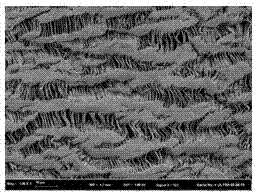Preparation method of composite polytetrafluoroethylene nano-filtration membrane
A polytetrafluoroethylene and composite nanofiltration membrane technology, which is applied in chemical instruments and methods, membrane technology, semi-permeable membrane separation, etc., can solve the problems of complex structure and complex preparation process of nanofiltration membranes
- Summary
- Abstract
- Description
- Claims
- Application Information
AI Technical Summary
Problems solved by technology
Method used
Image
Examples
Embodiment 1
[0027] (1) Activation: Submerge the hydrophobic polytetrafluoroethylene flat membrane in a 0.1% mass concentration of sodium dodecylbenzenesulfonate aqueous solution for 12 hours; take it out and dry it in the air to obtain an active base membrane;
[0028] (2) Water phase impregnation: immerse the active base film described in step (1) in an aqueous solution of 0.1% piperazine by mass concentration, stay for 30 minutes, take it out and dry it in the air to obtain the intermediate film 1;
[0029] (3) Oil phase impregnation: immerse the intermediate film 1 described in step (2) in the n-hexane solution of trimesoyl chloride with a mass concentration of 0.1%, stay for 30 minutes, and then place it in the air to dry to obtain the intermediate film 2 ;
[0030] (4) Water phase impregnation: immerse the intermediate membrane 2 described in step (3) in an aqueous solution of piperazine with a mass concentration of 3.0%, stay for 10 minutes, take it out and dry it to obtain the inte...
Embodiment 2
[0035] (1) Activation: Submerge the hydrophobic polytetrafluoroethylene flat film in a 4.0% mass concentration of sodium dodecylbenzenesulfonate aqueous solution for 5 minutes; take it out and dry it in the air to obtain an active base film;
[0036] (2) Water phase impregnation: immerse the active base film described in step (1) in an aqueous solution of 5.0% by mass concentration of p-phenylenediamine, stay for 5 seconds, take it out and dry it in the air to obtain the intermediate film 1;
[0037] (3) Oil phase impregnation: immerse the intermediate film 1 described in step (2) in a toluene solution of 5.0% mass concentration of isophthaloyl chloride, stay for 5 seconds, and then place it in the air to dry to obtain the intermediate film 2 ;
[0038](4) Water-phase impregnation: immerse the intermediate film 2 described in step (3) in an aqueous solution of 0.1% p-phenylenediamine in mass concentration, stay for 30 minutes, take it out and dry it to obtain the intermediate ...
Embodiment 3
[0043] (1) Activation: Submerge the hydrophobic polytetrafluoroethylene flat membrane in a 2.0% mass concentration of sodium dodecylbenzenesulfonate aqueous solution for 1 hour; take it out and dry it in the air to obtain an active base membrane;
[0044] (2) Water phase impregnation: immerse the active base film described in step (1) in an aqueous solution of ethylenediamine with a mass concentration of 3.0%, stay for 10 minutes, take it out and dry it in the air to obtain the intermediate film 1;
[0045] (3) Oil phase impregnation: immerse the intermediate film 1 described in step (2) in a n-heptane solution of 3.0% by mass concentration of terephthaloyl chloride, stay for 10 minutes, and then place it in the air to dry to obtain an intermediate membrane2;
[0046] (4) Water phase immersion: immerse the intermediate membrane 2 described in step (3) in an aqueous solution of 5.0% mass concentration of ethylenediamine, stay for 5 seconds, take it out and dry it to obtain the ...
PUM
 Login to View More
Login to View More Abstract
Description
Claims
Application Information
 Login to View More
Login to View More - R&D
- Intellectual Property
- Life Sciences
- Materials
- Tech Scout
- Unparalleled Data Quality
- Higher Quality Content
- 60% Fewer Hallucinations
Browse by: Latest US Patents, China's latest patents, Technical Efficacy Thesaurus, Application Domain, Technology Topic, Popular Technical Reports.
© 2025 PatSnap. All rights reserved.Legal|Privacy policy|Modern Slavery Act Transparency Statement|Sitemap|About US| Contact US: help@patsnap.com

